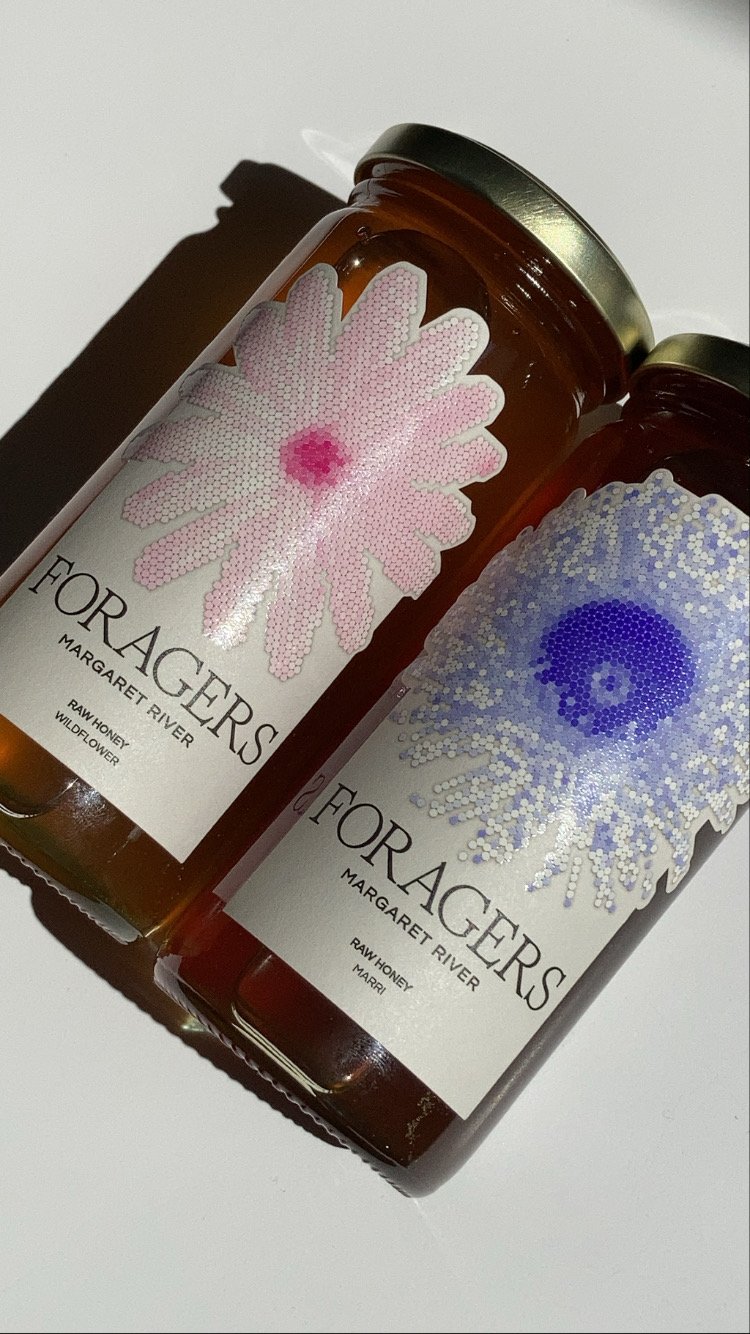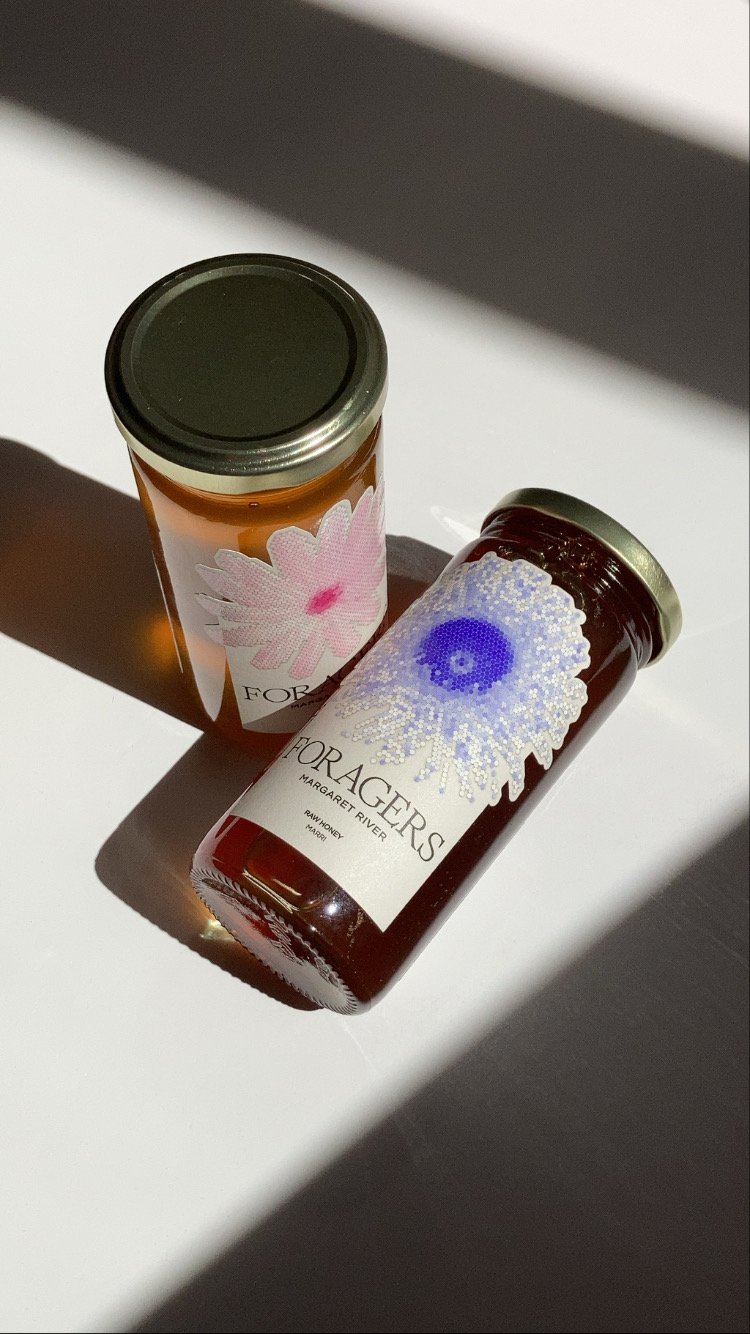Antimicrobial Honey
A Journey to the Hives
Margaret River region boasts diversity – from the coastal heathland, which face the western evening sunsets to Karri forests, which have majestic clean cream trunks and a towering canopy 75m up.
Inland the native, wild Jarrah and Marri forests, boast an array of plant and animal species.
Foragers honey has a small apiary, based on the edge of the native forest.
Medicinal importance of honey has been documented in the world's oldest medical literatures, and since the ancient times, it has been known to possess antimicrobial property as well as wound-healing activity. The healing property of honey is due to the fact that it offers antibacterial activity, maintains a moist wound condition, and its high viscosity helps to provide a protective barrier to prevent infection.
The antimicrobial activity in most honeys is due to the enzymatic production of hydrogen peroxide. However, another kind of honey, called non-peroxide honey (viz., manuka honey), displays significant antibacterial effects even when the hydrogen peroxide activity is blocked. Its mechanism may be related to the low pH level of honey and its high sugar content (high osmolarity) that is enough to hinder the growth of microbes. .
The use of traditional medicine to treat infection has been practiced since the origin of mankind, and honey produced by Apis mellifera (A. mellifera)bees is one of the oldest traditional medicines considered to be important in the treatment of several human ailments.
The bees are capturing a moment of time, a season, a place and the properties of the flora. Several of the species have natural wellness benefits and healing properties.
Benefits of Honey
Benefits of Honey
Honey has been used for it’s health and wellness benefits for centuries.
Honey has powerful antimicrobial effects against pathogenic and non-pathogenic micro-organisms (yeasts and fungi), even against those that developed resistance to many antibiotics.
Some beneficial uses are:
Hay Fever: Local pollen helps to desensitise.
Sore throats: Antibacterial and southing, often combined with lemon.
Wound Healing: Antibacterial, anti inflammatory, antioxidant has high acidity and an osmotic effect.
Psoriasos: Helps soothe skin and wounds.
Eczema: Soothes skin and helps with infections e.g. Staphylococcus.
Acne: Antibacterial in pores.
Digestion: Known to soothe digestive issues, such as acid reflux and can help regulate bowel movements.
True Terroir – A Sense of Place
As an ex winemaker the word terroir is often used to describe a combination of environmental factors, which affect the growing conditions in a vineyard.
In general, though, it means “a sense of place.” Essentially, terroir encompasses all of the natural conditions, which influence the biology of the vines, and thus the distinctive characteristics of the grapes. These ultimately are the factors, which give a wine its unique characteristics.
The terroir is the combination of the climate, the soil, aspect and the landscape. It is the combination of an infinite number of these factors, temperatures, rainfall, sunlight hours, slope and drainage to name a few. All these factors react with each to form what the French winegrowers term terroir.
In a vineyard, which is managed there are a number of human influences – therefore maybe true terroir is found in the natural, native species?
The native forests and wildflowers are a diversity of species of plants growing in the environment, which they have evolved. They ecologically depend on the conditions, in which they grow, the soil, climate and even the other species such as birds and animals, which interact with them. The ecosystem has a complex range of connections to other species and the environment, in which they live and grow.
Each year is seasonally different, the weather patterns influence the species and timing of growth and flowering, if flowering occurs at all. Some species may flower only every few years – thus each year is unique.
Honey is a true expression of terroir, a reflection of the place and species from where it is sourced. Each honey captures the distinctive flavours and natural wellness benefits from the species, which they are foraged.
At Foragers our bees forage the native forests and wildflowers of Australia’s South West, part of an International Biodiversity hotspot. The majestic Jarrah, Marri and Karri forests, with a large diversity of other flora produce a unique nectar.
We ethically harvest honey, which is excess to the bees.
Foragers invites you to experience the distinctive flavours, natural power and wellness from our Exceptional Honey.
How bees see the world - Foragers Honey Packaging
How bees see the world
Or a critique of the human being as the center of absolutely everything.
Accustomed to hearing about the benefits that brands bring to human beings, I thought we had the opportunity to talk to consumers in a different way, to tell them something interesting beyond how good honey is for our health.
Tom Hayward is a beekeeper, he ethically harvests the honey that his bees forage from the native forests and landscapes of the Margaret River region, in Western Australia. Month after month he managed to infect me with his passion for beekeeping and bees, which led me to do a very exhaustive research on the day to day life of bees. How they move, how they interact... how they see.
Foragers Honey labels are a representation of this very thing. How flowers appear from the perspective of the bees flying free foraging in the native landscape. Kaleidoscopic shapes that form in a hexagonal grid, in a world where red colours don't exist.
Honey is a gift of nature, and this is how we wanted to pay tribute to it.
Design by Mayes Imbernon. https://www.behance.net/mayesimbernon
A Journey to the Hives
A Journey to the Hives
Margaret River region boasts diversity – from the coastal heathland, which face the western evening sunsets to Karri forests, which have majestic clean cream trunks and a towering canopy 75m up.
Inland the native, wild Jarrah and Marri forests, boast an array of plant and animal species.
Foragers honey has a small apiary, based on the edge of the native forest.
As we head East inland from the townsite of Cowaramup, a small town, historically built on dairy farming. We leave the comfort of a sealed road and wind our way on a dusty red gravel road, with the dust cloud rising behind. On the road edge native trees tower, some gnarly and roughly barked, cast shadows of light over the verge and offer windows of views across the fields.
We reach the edge of the forest, turning down a narrow track. As we drop down into low ground, a natural creek line, a pair of wedgetail eagles soar above in the blue skies, owning the sky. The calling of wild mountain duck can be heard, possibly alarmed by the eagles presence. The creek line has a range of species, enjoying the natural water supply. A greener strip of vegetation, tea tree, with blackbutt trees rising above the lower bushes.
A further few hundred meters we are surrounded by the native bushland, casting dappled light over the golden grass. The sounds of the bush echo, with a flock of Black cockatoos calling each other from the tree canopy, the leaves rustle and a small thud of as they chew nuts, which fall to the forest floor. Parrots flutter from tree to tree, with their distinctive chirp, a flash of their green feathers glisten in the sun rays. Beyond this a hum of bees, can be heard as the background rhythm of the forest sounds.
In the dappled light a group of paperbark-coloured boxes sit, with a small opening facing east, the darting of bees coming and going from the hives become distinct as we approach. Foragers pride themselves on being caretakers of bees, allowing them to naturally forage the surrounding bush. The buzz of activity from the hives becomes more apparent. The entrances of the hives bees, peppered with bees, peeking their heads out and a second later they take to the sky to forage the trees and plants for nectar and pollen. Others arrive at the entrance, landing with their legs, shining with florescent orange pollen and crawl inside the hive to share their foraged bounty. The sweet smell of the hives drifts in the slight breeze, a sweetness along with the smell of dry grass, makes an appealing combination.
The bees are capturing a moment of time, a season, a place and the properties of the flora. Many of the species have natural wellness benefits and healing properties.




